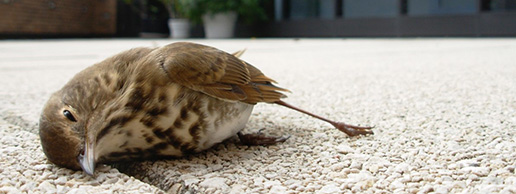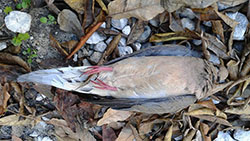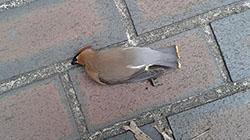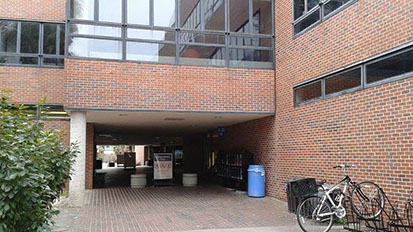
Bird Window Collision Project at UF
If You Find a Bird | Contact Us
 "Except for habitat destruction, collisions with clear and reflective sheet glass and plastic cause the deaths of more birds than any other human-related avian mortality factor."
"Except for habitat destruction, collisions with clear and reflective sheet glass and plastic cause the deaths of more birds than any other human-related avian mortality factor."
-Daniel Klem, Acopian Center for Ornithology, Muhlenberg College
 Today, birds are constantly facing various threats to their survival, both in the air and on the ground. Anthropogenic dangers include run-ins with airplanes, deforestation of habitat, pollution, outdoor cats, and more. A highly fatal obstacle to be added to this continuing list is one that most people do not consider: collisions with reflective and/or glass windows. Window collisions are considered by ornithologists (those who study birds) to be the second largest cause of human-influenced bird mortality after habitat loss, causing an estimated 1 billion deaths just in the United States. Many windows are transparent enough or reflective enough to make a bird unable to see it as a barrier; many birds fly into the window seeing the reflection of trees, other vegetation, or the sky. However, they are instead met with severe head trauma, of which over half of
whom die from. Dangerous windows for birds range from those of large urban buildings to common
residential ones, and all in between.
Today, birds are constantly facing various threats to their survival, both in the air and on the ground. Anthropogenic dangers include run-ins with airplanes, deforestation of habitat, pollution, outdoor cats, and more. A highly fatal obstacle to be added to this continuing list is one that most people do not consider: collisions with reflective and/or glass windows. Window collisions are considered by ornithologists (those who study birds) to be the second largest cause of human-influenced bird mortality after habitat loss, causing an estimated 1 billion deaths just in the United States. Many windows are transparent enough or reflective enough to make a bird unable to see it as a barrier; many birds fly into the window seeing the reflection of trees, other vegetation, or the sky. However, they are instead met with severe head trauma, of which over half of
whom die from. Dangerous windows for birds range from those of large urban buildings to common
residential ones, and all in between.
Although reflective windows are problematic for all birds at all times of the year, collisions take their greatest toll on avian population numbers during migration season, when large flocks pass through all forms of human settlements. Migrants already have limitless odds against them in their long and risky journeys, which for some species can be up to 35,000 km round trip. Florida in particular is a common migratory route and destination, providing refuge for an abundance of bird species that travel from extreme northern winter conditions. This is a great map on bird migrations and where do they go. It is unfortunate and unnecessary that so many migratory individuals should come to the end of their challenging journeys in this wasteful way.
 However, hope lies behind these ongoing casualties in that this problem is avoidable and recoverable. Window tinting and blinds provide much safer cities and suburbs for birds to fly through. Bird-friendly building must be incorporated into architecture to reduce this significant threat to those soaring in the sky. Here at the University of Florida, we are taking on this initiative to make our 2,000 acre campus safe for birds. We are currently in the process of collecting bird strike data across campus, determining factors such as how many birds are killed, what species are most affected, what buildings are most responsible, and more. After gathering the facts about campus bird collisions, the data will be demonstrated to University of Florida officials who can make the changes that these buildings need to mitigate bird impacts. Please join us in this effort by reporting any dead bird sightings on campus to our iNaturalist Bird Collision Project app, or by notifying us if one is spotted. Together, we can work with the local community to record bird strike deaths. The more slain birds we find on campus now, the less we will find at our institution in the future.
However, hope lies behind these ongoing casualties in that this problem is avoidable and recoverable. Window tinting and blinds provide much safer cities and suburbs for birds to fly through. Bird-friendly building must be incorporated into architecture to reduce this significant threat to those soaring in the sky. Here at the University of Florida, we are taking on this initiative to make our 2,000 acre campus safe for birds. We are currently in the process of collecting bird strike data across campus, determining factors such as how many birds are killed, what species are most affected, what buildings are most responsible, and more. After gathering the facts about campus bird collisions, the data will be demonstrated to University of Florida officials who can make the changes that these buildings need to mitigate bird impacts. Please join us in this effort by reporting any dead bird sightings on campus to our iNaturalist Bird Collision Project app, or by notifying us if one is spotted. Together, we can work with the local community to record bird strike deaths. The more slain birds we find on campus now, the less we will find at our institution in the future.


 Location: http://yourdomain.edu
Location: http://yourdomain.edu